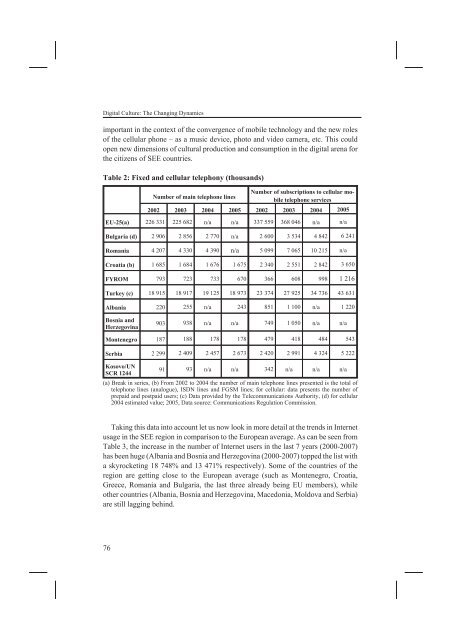D:\Documents and Settings\Ana\My Documents\Biserka-knjiga ...
D:\Documents and Settings\Ana\My Documents\Biserka-knjiga ...
D:\Documents and Settings\Ana\My Documents\Biserka-knjiga ...
Create successful ePaper yourself
Turn your PDF publications into a flip-book with our unique Google optimized e-Paper software.
Digital Culture: The Changing Dynamics<br />
important in the context of the convergence of mobile technology <strong>and</strong> the new roles<br />
of the cellular phone – as a music device, photo <strong>and</strong> video camera, etc. This could<br />
open new dimensions of cultural production <strong>and</strong> consumption in the digital arena for<br />
the citizens of SEE countries.<br />
Table 2: Fixed <strong>and</strong> cellular telephony (thous<strong>and</strong>s)<br />
Number of main telephone lines<br />
Number of subscriptions to cellular mobile<br />
telephone services<br />
2002 2003 2004 2005 2002 2003 2004 2005<br />
EU-25(a) 226 331 225 682 n/a n/a 337 559 368 046 n/a n/a<br />
Bulgaria (d) 2 906 2 856 2 770 n/a 2 600 3 534 4 842 6 241<br />
Romania 4 207 4 330 4 390 n/a 5 099 7 065 10 215 n/a<br />
Croatia (b) 1 685 1 684 1 676 1 675 2 340 2 551 2 842 3 650<br />
FYROM 793 723 733 670 366 608 998 1 216<br />
Turkey (c) 18 915 18 917 19 125 18 973 23 374 27 925 34 736 43 631<br />
Albania 220 255 n/a 243 851 1 100 n/a 1 220<br />
Bosnia <strong>and</strong><br />
Herzegovina<br />
903 938 n/a n/a 749 1 050 n/a n/a<br />
Montenegro 187 188 178 178 479 418 484 543<br />
Serbia 2 299 2 409 2 457 2 673 2 420 2 991 4 324 5 222<br />
Kosovo/UN<br />
SCR 1244<br />
91 93 n/a n/a 342 n/a n/a n/a<br />
(a) Break in series, (b) From 2002 to 2004 the number of main telephone lines presented is the total of<br />
telephone lines (analogue), ISDN lines <strong>and</strong> FGSM lines; for cellular: data presents the number of<br />
prepaid <strong>and</strong> postpaid users; (c) Data provided by the Telecommunications Authority, (d) for cellular<br />
2004 estimated value; 2005, Data source: Communications Regulation Commission.<br />
Taking this data into account let us now look in more detail at the trends in Internet<br />
usage in the SEE region in comparison to the European average. As can be seen from<br />
Table 3, the increase in the number of Internet users in the last 7 years (2000-2007)<br />
has been huge (Albania <strong>and</strong> Bosnia <strong>and</strong> Herzegovina (2000-2007) topped the list with<br />
a skyrocketing 18 748% <strong>and</strong> 13 471% respectively). Some of the countries of the<br />
region are getting close to the European average (such as Montenegro, Croatia,<br />
Greece, Romania <strong>and</strong> Bulgaria, the last three already being EU members), while<br />
other countries (Albania, Bosnia <strong>and</strong> Herzegovina, Macedonia, Moldova <strong>and</strong> Serbia)<br />
are still lagging behind.<br />
76



